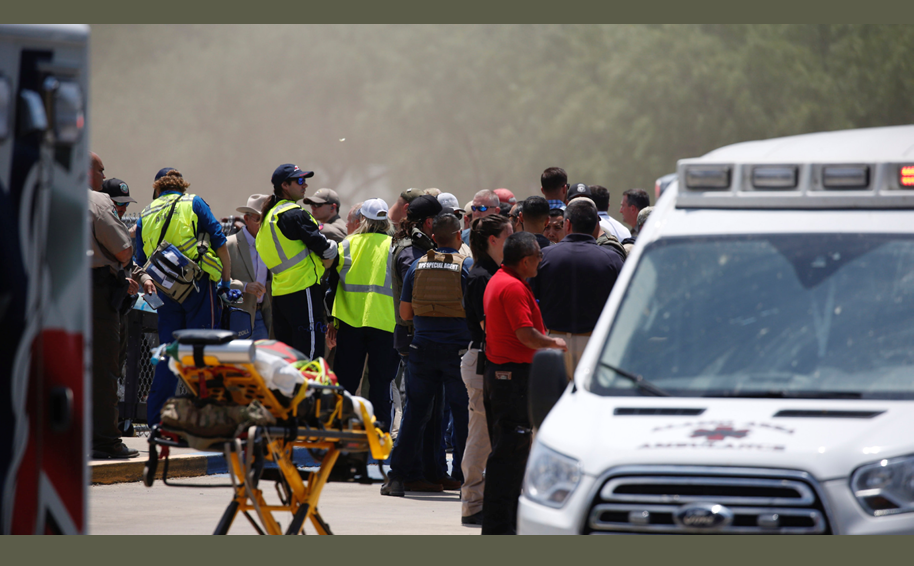On May 24, a shooter in Uvalde, Texas, killed 19 children and two adults, just 10 days after a mass shooting in Buffalo, New York, that killed 10 people and injured three others. Another shooting in Tulsa, Oklahoma, killed five people including the shooter on June 1, the 20th mass shooting since the May 24 mass shooting in Uvalde.
A familiar news cycle has unfolded, rife with “the sickening mix of shock and familiarity that usually follows a mass shooting,” as Columbia Journalism Review’s Jon Allsop wrote, and independent news outlets have emphasized the deadly results of lax gun laws, widespread gun ownership, and belligerent politicians and media.
The U.S. houses more guns than people. After a dramatic increase in gun purchases during recent years — including the record of 39.7 million in 2020 — there are more than 120 guns for every 100 Americans.
A 2018 study of 171 countries from 1966 to 2012 found that “firearm ownership rates appeared to be a statistically significant predictor of the distribution of public mass shooters worldwide. Many of the nations in this study that ranked highest in firearm ownership rates also ranked highly in public mass shooters per capita.”
The Uvalde shooter bought two assault rifles the day he turned 18, the first day he was legally able. Popular Information noted that if the legal age limit for gun ownership had been 21, the massacre may not have happened.
In the wake of these murders, Canada quickly moved to pass legislation to buy back assault weapons and limit the sale and transfer of handguns. The government will also require all rifle magazines to be altered to fit a maximum of five rounds and that it will ban the sale of large-capacity magazines.
Such policies aiming to reduce the number of guns in the U.S. are popular. A 2018 poll by Guns Down America showed that 67% of Americans support stricter gun laws, including measures such as required licenses for handguns, a voluntary government buyback program, background checks, and a ban on semi-automatic weapons.
But currently, no government agency regulates safety for guns and ammunition, as a law passed in 1972 forbids the Consumer Product Safety Commission from evaluating the safety of guns. The gun industry received further special legal protections in 2005 from the Protection of Lawful Commerce in Arms Act, providing sweeping legal immunity.
The Intercept discussed the favored ammunition of mass shooters: hollow-point, or expanding, bullets, which open upon impact to cause more damage to their targets. The use of expanding rounds on the battlefield is a war crime, but the purchasing of hundreds of them prior to mass shootings has failed to raise red flags prior to several deadly killings.
Regulating this ammunition could be another avenue to curbing mass shootings, with background checks, seller licensing, age limits, and bulk-sale reporting. However, The Intercept also made clear “exactly what the AR-15 is: It is a weapon of war. It was made to blow humans apart.”
After the shooting, President Joe Biden bemoaned the U.S.’s lack of gun control, saying, “As a nation, we have to ask, ‘When in God’s name are we going to stand up to the gun lobby?” But, as In These Times pointed out, the military Biden oversees relies on a weapons industry that overlaps — sometimes entirely — with the domestic gun industry, as seen in Uvalde.
Daniel Defense Inc. is a Georgia-based company that manufactured the DDM4 Rifle used in the Texas shooting. The pentagon struck a contract with the company earlier this year for up to $9.1 million. The company additionally received over 100 federal contracts, and even some government loans.
Daniel Defense prides itself on making assault rifles, including those used by civilians, which are the type of weapons Democrats most want to regulate. But the U.S. military’s heavy reliance on the arms industry may play a role in curbing domestic gun control efforts.
After this 212th mass shooting in just 144 days in 2022, according to a review by Media Matters, “Fox News has once again consulted its well-worn mass shooting playbook, which calls for blaming everything but the guns.”
Fox personalities cited insufficient campus security; fear of, rather than appreciation for guns; anti-police sentiments “forcing” people not to call the police; kids fearing retaliation for “snitching”; poor fencing around the elementary school; a lack of “man traps”; the decay of “Judeo-Christian” principles; mental health; insufficient knowledge of mass shooters’ psychology; and a lack of “discipline” in attacked schools.
Meanwhile, Fox News Host Tucker Carlson drew praise from white nationalist outlets for giving mainstream attention to their “great replacement theory” after the shooting by a white supremacist in Buffalo, New York.
For Mother Jones, Mark Follman contested the common notion that mass shootings are horrific, but inevitable, tragedies that no one will do anything about. “This narrative has become part of the problem itself — in some cases possibly even fueling the escalating cycle of mass shootings,” Follman said. “That’s because it validates the recurring violence, framing it as an indefinite feature of our reality.”
Research shows mass shooters notice this trend, hoping that sensational coverage focuses on their manifestos, sinister online photos, or livestreams. Follman said, “They want notoriety, and they seek justification and credibility for their acts of violence. And in the message that America will never stop these mass shootings, they find such affirmation.”
Rather than apathy, America needs relentless effort to create stronger gun laws, quash violent political extremism, invest in mental health systems, and build community-based violence prevention programs, according to Follman. “In a society with 400 million firearms that are easy to obtain, even all that may only be a start. But it will be a powerful rebuttal to the nihilism that mass shooters feed on — and to the hopelessness about this epidemic that so many Americans once again feel.”
Image by Dario Lopez-Mills / AP

